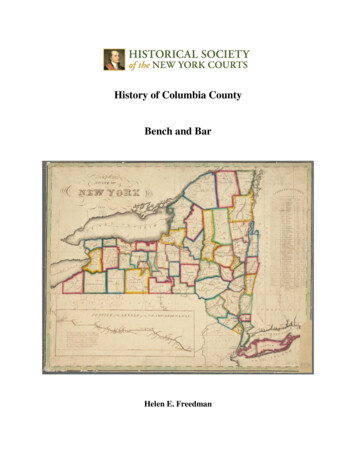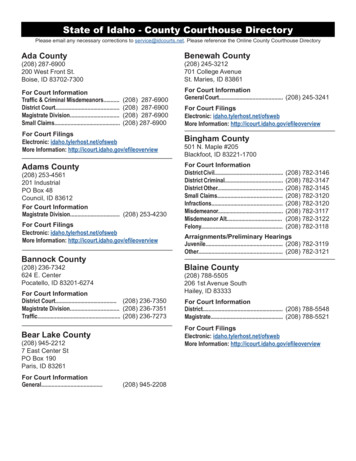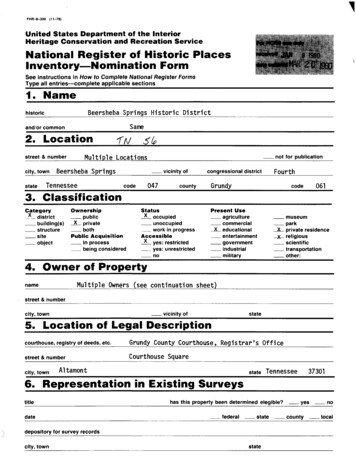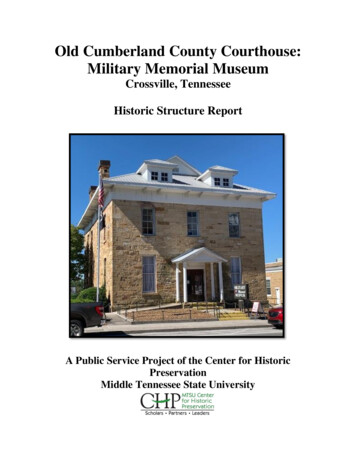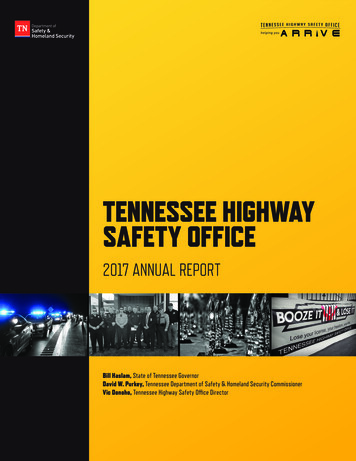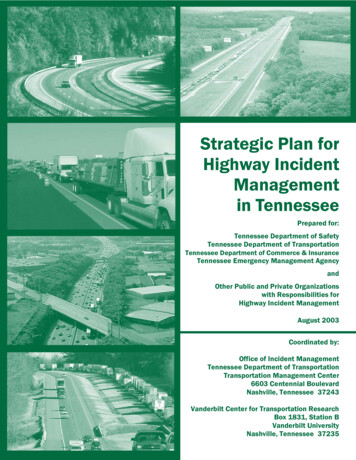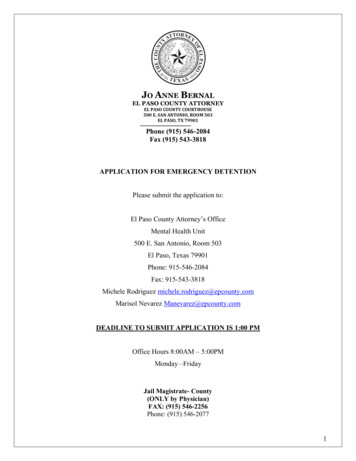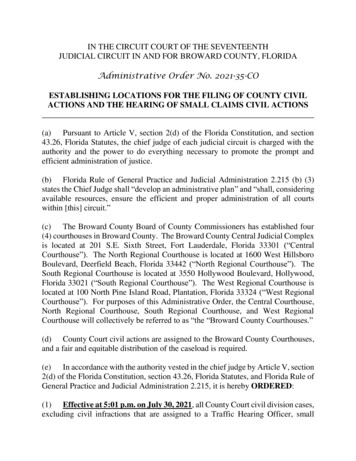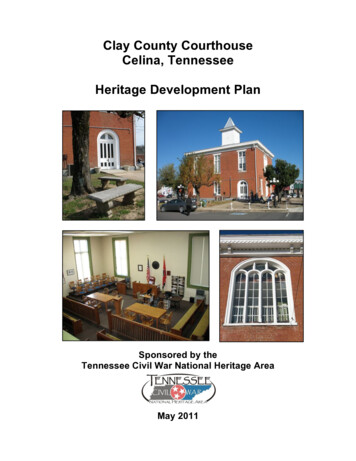
Transcription
Clay County CourthouseCelina, TennesseeHeritage Development PlanSponsored by theTennessee Civil War National Heritage AreaMay 2011
Prepared By:Seminar in American Material Culture, MTSU, Spring 2011:Ashley BrownLeslie CrouchLeigh Ann GardnerTennessee Civil War National Heritage Area:Dr. Carroll Van West, DirectorAnne-Leslie Owens, Programs ManagerMichael T. Gavin, Preservation SpecialistJessica Bandel, Graduate Research Assistant
TABLE OF CONTENTSIntroduction and Methodology . 1History . 3Brief History of Celina. 3Political Context of the Creation of Clay County . 3History and Significance of the Courthouse . 8Needs Assessment . 19Maintenance Recommendations . 38Maintenance and Restoration Recommendations Timetable . 44Adaptive Reuse Possibilities . 46Possible New Uses for the Courthouse. 46New Uses for Other Tennessee Courthouses. 50Accessibility Considerations. 50Funding and Assistance Sources . 52Bibliography . 58Appendix . 61A: Request letter from Clay County Mayor Dale Reagan, February 4, 2011B: Tennessee Historical Commission-Federal Preservation Grants webpageC: Frequently Asked Questions about Historic Preservation Grants from the TennesseeHistorical Commission/ National Park Service, June 2011D: Application for Historic Preservation Grant, Tennessee Historical Commission/National Park Service, June 2011E: Tennessee’s Local Archives ProgramF: Archives Guidelines: A Self-Evaluation Handbook for Developing Archives Programs inCounties, Cities, and Towns in the State of TennesseeG: 2011 Tennessee Archives Institute (October 19-21, 2011) registration formH: Tennessee Records Advisory Board (THRAB), State and National Archival Partnership(SNAP) Regrant, 2010-11 Guidelines & Application Instructions (2011-12 not yet available)I: Direct Grants to Local Government Archives, Application Procedures and Documentation(2011-12 not yet available)
INTRODUCTION AND METHODOLOGYTennessee’s Clay County Courthouse, located along the Kentucky border in Celina, is amodest yet stately two-story brick building of restrained Italianate design. Plans forconstruction of this courthouse began shortly after the Tennessee ConstitutionalConvention of 1870 created the new county from parts of Jackson County and OvertonCounty. Designed by D.L. Dow, the Clay County Courthouse was completed in 1873and is one of Tennessee’s oldest operating courthouses.Celina, located at the juncture of the Obey and Cumberland rivers, was once asignificant port and the river has defined much of Clay County’s history. Clay County'searly residents farmed the area and used the Cumberland River to transport crops andlivestock to major markets. During the Civil War, many skirmishes took place up anddown the Cumberland River to control the movement of barges laden with supplies. Aswas the case in many counties of the Cumberland Plateau, local communities weredivided in their loyalties, with brother fighting against brother.Telling these powerful stories of Civil War and Reconstruction-era Tennessee—thevicious warfare, the demands of the homefront and occupation, the freedom ofemancipation, and the enduring legacies of Reconstruction—is the goal of theTennessee Civil War National Heritage Area (TCWNHA). A partnership unit of theNational Park Service, the Tennessee Civil War National Heritage Area is managed bythe Center for Historic Preservation at Middle Tennessee State University. TheHeritage Area responds to requests from communities, and offers professional servicesand outreach while training students in heritage development.In the fall of 2010, Dr. Doug Jones of the Celia Main Street Revitalization Committeefirst contacted the Tennessee Civil War National Heritage Area regarding the ClayCounty Courthouse. With plans to move the courtroom and county offices to a newlocation at the community center, County Mayor Dale Reagan asked for the Heritage1
Area’s assistance in determining possible new uses for the Clay County Courthouse.(see Appendix A).The Clay County Courthouse, completed in 1873, is a significant Reconstruction-eracourthouse in Tennessee and clearly fits within the interpretation period of theTennessee Civil War National Heritage Area. In response to the request from ClayCounty, Heritage Area staff assembled a research team. The team included a graduateresearch assistant with the Tennessee Civil War National Heritage Area and threegraduate students in Dr. Carroll Van West’s Seminar in American Material Culture.MTSU Center for Historic Preservation and Tennessee Civil War National Heritage Areastaff coordinated the site visits, supervised the students, and provided instruction andfeedback.The following heritage development plan is designed to provide a better understandingof the possibilities for more fully utilizing this heritage asset to tell Clay County’s uniquestory. It will hopefully provide a strong foundation with which county leadership canmake important decisions. The report includes a 1) history of the area and the buildingto provide context and explain the significance of the structure, 2) an assessment of thephysical needs of the building with particular emphasis on areas in need of repair andreplacement, 3) maintenance recommendations for keeping the building in its bestcondition and monitoring any ongoing concerns, 4) adaptive reuse options exploringcreative new ways to use the building as a community asset, and 5) key funding andassistance sources.The Tennessee Civil War National Heritage Area would like to thank the many ClayCountians who have welcomed us on our visits, offered recollections about the past anddreams for the future. Special thanks go out to the following: Dr. Doug Young of theMain Street Revitalization Committee; Ray Norris, Director of Clay County EconomicDevelopment at the Clay County Chamber of Commerce; Mary Loyd Reneau, Historian,Clay County Museum; Diana Donaldson of the Clay County Chamber of Commerce andthe Main Street Revitalization Committee; and Clay County Mayor Dale Reagan.2
HISTORY--BRIEF HISTORY OF CELINAThe land on which the original town of Celina is situated was established as a town sitein 1832 and was incorporated on February 2, 1848. Celina received its name in honorof the daughter of Moses Fiske, a prominent educator in the area.1 The Union Armyburned the old town of Celina during the Civil War, leaving only four houses remainingas survivors of the attack.2 The new town of Celina was built in 1870 and wasdesignated the county seat of Clay County, formed in 1870 from Overton and Jacksoncounties. After 1863, the “Old Town” of Celina functioned primarily as a businessdistrict.3 Celina was an important town in the region. Located in the midst of theregion’s timber forests, it was closely identified with logging and with rafting during theperiod 1870 to 1930.4 As noted Upper Cumberland folklorist William Lynwood Montellstates, “Celina, Gainesboro, and Carthage in particular were the big regional raftingcenters, as each received logs from the Obey-Wolf, Roaring and Caney Forkhinterlands respectively, and conveyed them on to Nashville in large log flotillas.”5POLITICAL CONTEXT OF THE CREATION OF CLAY COUNTYThe Arnell Law of 1865, a franchise bill, stripped all former Confederates of the right tovote. For Confederate soldiers, the disenfranchisement was to last five years. ForConfederate leaders, it was to be a fifteen year wait. The plan also made the issuanceof voter certificates a responsibility of the county court clerks. 6 The aim of the plan, tokeep former Confederates from voting, was not successful because the clerks tended to1Clay County Homecoming Committee, History of Clay County (Paducah, KY: Turner PublishingCompany, 1986), 30.2William Curtis Stone, Sr., Historical Sketches of Clay County, Tennessee. (Nashville, TN: September 1,1962), 4.3Clay County Homecoming Committee, 30.4William Lynwood Montell, Don’t Go Up Kettle Creek: Verbal Legacy of the Upper Cumberland(Knoxville: University of Tennessee Press, 1983), 107.55Ibid., 106-107.6Lewis L. Laska, A Legal and Constitutional History of Tennessee, 1772-1972. (Memphis: Memphis StateUniversity, 1976), 628.3
issue voter certificates liberally. The results of the election that followed on August 5reflected this reality when a majority of voters cast their ballots in favor of theconservatives. Even Samuel M. Arnell, after whom the bill is named, was defeated in hisbid for Congress. To correct the failures of the Arnell Law, the legislature held specialelections for the vacated offices. The result of this election was the appointment of fourRadicals and twenty-one conservatives; however, the conservatives were denied theirseats. Barely mustering a quorum, the legislature then passed a revised franchise bill.The revised bill upheld many of the provisions of the Arnell Law but overhauled theregistration process. The issuance of voter certificates was made the responsibility of“executive-appointed ‘Commissioners of Registration.’” The revised bill also revoked allof the previously issued voter certificates.7A number of events combined to successfully demolish the disenfranchisement ofTennessee conservatives. The Brownsville decision restored the right to vote to 30,000ex-Confederates. Governor William G. Brownlow, a staunch Radical, resigned from thegovernorship in February 1869 to accept a seat in the U.S. Senate. He was succeededby DeWitt C. Senter, a man “who cared more for re-election” than upholding the Radicalagenda. During his campaign, Senter “dramatically endorsed universal suffrage” andannulled the franchise law by replacing Brownlow’s commissioners with his own whothen issued thousands of voter certificates to ex-Confederates.8 Senter was reelected tothe governorship and the Conservative take-over of the general assembly. Tennesseelegal historian Lewis Laska states that when the newly elected general assembly met onOctober 4, 1869, “the Radical era was at an end.”9In his address to the legislature on October 12, Senter introduced the idea of having aconstitutional convention. The House and the Senate followed suit by introducing billscalling for a convention. The House’s bill focused on addressing the “number andappointment of delegates.” The Senate’s bill called for a “limited convention” whichwould focus on only four issues: “suffrage, the judiciary, taxes, and the formation of new7Ibid., 629.Ibid., 631.9Ibid., 632.84
counties.” A compromise between the houses was reached on November 15, 1869. Thebill called for a vote to be held on December 18, 1869 to allow the people to call for aconvention to “amend, revise, or form and make a new constitution for the State.”Additionally, voters would choose seventy-five delegates to attend the convention.10 Theresults were 50,520 votes in favor of the convention with only 10, 020 votes against it.The convention was convened on January 10, 1870, signifying the end of RadicalReconstruction in Tennessee.11The convention was held for three reasons. First, the franchise laws of the Brownlowlegislature had to be removed from the constitution. Second, the convention sought toremove from office those who had been elected by the minority. Third, it symbolized areturn to “majoritarian” rule and restored the public’s confidence in the state’sgovernment. Under the intense scrutiny of the federal government, the delegates setabout revising Tennessee’s constitution.12 The typical convention delegate was“personified in William H. Williamson,” says Laska. Williamson was a lawyer fromLebanon who lost an arm for the Confederacy during the war and married the widow ofJohn Hunt Morgan. Under the new constitution, he served as a circuit judge and laterhad a successful law practice after resigning the bench. Very few delegates wereRadicals, and their influence during the convention was weak.13 The convention upheldmuch of the 1834 Constitution with great changes being made only on the issues ofsuffrage, the judiciary, the process of amending, and restricting the governor’s power. 14One of the major concerns for the convention delegates was the formation of newcounties. George E. Seay, delegate for the counties of Smith, Sumner, and Macon,introduced a resolution to amend the constitution “so that new Counties may beestablished by the Legislature.” The proposed county had to be at least two hundredsquare miles and had to have a population of at least three hundred and fifty voters.Additionally, the resolution stipulated the following:10Ibid., 632.Ibid., 633.12Ibid., 634.13Ibid., 635.14Ibid., 636.115
No line of such County shall approach the Court-house of any old County fromwhich it may be taken nearer than eight miles, and no part of a County shall betaken to form such County or a part thereof, without a majority of the qualifiedvoters in such part taken off shall consent. And where an old County may bereduced for the purpose of forming a new one, the area of said old County shallnot be reduced to less than three hundred and fifty square miles.15In response to the resolution, the convention formed a seven-man committee called theCommittee on New Counties and County Lines to oversee the formation of newcounties. George Seay served as chairman. All requests to form new counties, as wellas all proposed amendments to the above resolution were required to be reviewed bythe committee prior to the convention’s approval.16The Minority Report of the Committee on New Counties and County Lines stated they“cannot concur” with the requirement of the Constitution of 1834 for new countyformation which said no county shall be less than 625 square miles. They noted thisrequirement was a result of the “sparse population of the then unsettled country,” andthat the founders did not plan originally to “inconvenience the many for the benefit of thefew.” The committee believed the formation of new counties should serve the wants andneeds of the people who should have “a convenient and accessible point of transactionof their legal, police and registration business.” The report further stated that if therequirements of the Constitution of 1834 were upheld by the convention, it would cause“annoyance and inconvenience to a very large portion of the tax-payers ofTennessee.” They argued the creation of new counties should be seriously consideredfor the communities that are willing to fund and construct new courthouses and jailswithout aid from the counties they leave.17The report also laid out all the benefits of new county formation, stating “the State willlose nothing.” They argued the people would benefit the most as those who resided farfrom the county seats often traveled great distances at their own expense, sometimes15Journal of the Proceedings of the Convention of Delegates Elected by the People of Tennessee, toAmend, Revise, or Form and Make a New Constitution for the State (Nashville: Jones, Purvis, & Co,1870), 27.16Ibid., 28.17Ibid., 267.6
“imperiling their lives by swimming swollen streams which they must cross undersubpoena.” The people who were required to return for a day or consecutive days hadthe greatest disadvantage as they were “too far off to go home, and sometimes too poorto pay for good lodging if procurable.” Even if they were able to afford accommodations,often times there were not enough rooms for “the miserable throng of litigants, jurorsand witnesses.” The emancipation of slaves also played a part in the decision to allownew county formation as “every man” had become “his own servant to do his work.” Thereport argued that a person’s prolonged absence from his house for court purposeswould greatly affect his family. Traveling to court “shall not be a journey of days” as thetime had ended “when a gentleman can go to court in his carriage, leaving a host ofservants to wait upon his household.”18The amendment proposed to create Clay County was introduced by Jackson Countydelegate Richard P. Brooks and read as follows:That the Constitution be so amended that there may be a new county formed outof the Counties of Jackson and Overton. Provided, That in the formation it shallcontain at least 400 qualified voters; and further, said new county shall contain atleast 300 square miles of territory, and shall not reduce either of the old counties,from which it is taken, below 500 square miles. Provided further, That the line ofsaid new county shall not approach either the old county seats nearer than tenmiles. Provided further, That a majority of qualified voters contained in said newcounty vote in favor of said new county. The county seat of the old counties, fromwhich said new county is formed, shall not be moved without a concurrence oftwo-thirds vote of both Branches of the Legislature.19Clay is a Constitutional County officially organized on December 17, 1870, the result ofthe 1870 Convention.20 The county was created to “relieve the difficulties” of those livingin the Northern parts of Overton and Jackson Counties and having to travel toLivingston or Gainesboro for court.21 The book History of Clay County, Tennesseestates, “When Clay County was created there were no roads. There were a few trailswhich were called roads. These were hard to travel over with anything other than horses18Ibid., 268.Ibid., 121.20J. B. Killebrew, Introduction to the Resources of Tennessee (Nashville: Tavel, Eastman & Howell,1874), 647.21National Register Nomination Form need citation information197
and in many places the going was hard on horseback.”22 The need for more roads wasa prevalent topic in the Clay County Court minutes for the first two years, and they spenta lot of time discussing the creation of roads and the appointment of road overseers.The topography of the area proved to be a major obstacle for those more northernresidents as they traveled to the county seats of Overton and Jackson. An 1874 reportby the Bureau of Agriculture described the Clay County landscape as follows:It is best to imagine a plain with a moderately undulating surface, nearly level tothe west. Then imagine the middle of this plain cut diagonally across from northeast to south-west by a valley of irregular outline nearly 600 feet deep, andaveraging a little more than one mile in breadth between the bases of theopposite hills. This is the valley of Cumberland River. Opening into it on the eastside near the center of the county, is the long, winding valley of Obey’s River,with a general direction from east to west. A number of small creeks emptyinginto these two rivers, have valleys of their own, extending outward, andseparated from each other by ridges or fingers of the plain to which the generalsurface of the county has been referred. These ridges and the intervals may becompared to the teeth of a saw, broad at the base and growing graduallynarrower toward the apex.23The need for a network of roads was also reinforced by the fact that the Obey andCumberland Rivers could only be used three and seven months of the year,respectively. These were the two main routes for the movement of goods to marketsand for bringing in supplies from Nashville. When the rivers were too low to benavigable, the goods were “carried in wagons either from Nashville or from Glasgow,Kentucky.24HISTORY AND SIGNIFICANCE OF THE COURTHOUSECourthouses serve an important purpose in American life. They serve as a place forcitizens to meet, to socialize, to engage in civic business. They are often the mostimportant location in town. The National Trust for Historic Preservation has noted, “Thecourthouse is one of the most important visual reference points in a county and, in many22Clay County Homecoming Committee, History of Clay County, Tennessee. (Paducah: TurnerPublishing Company, 1986), 13.23Killebrew, Introduction, 648.24Ibid., 653.8
instances, literally defines the surrounding townscape, giving it cohesion and unity.”25Edward T. Price notes, “The square brings together those who work there, those whocome to do business, and those who come merely to visit and loaf.”26 Often thecourthouse square is one of the earliest sections of town, the early focal point of acommunity. Price states that, “The square recapitulates the history of the town. Thecourthouse was its reason for being, its first central function, the seat of its creator.”27Other historians have noted the importance of the courthouse in nineteenth centurytowns. Wayne K. Durrill notes, “Yet there was more to civic space in nineteenth centuryAmerica than its use as a site for political conflict or a means to dominance.Specifically, public places shaped and formed ideas.”28 Some historians even note thatthe courthouse was often the most important building in a town. Conrad M. Arensbergremarks that, “The church, both as building and as institution, is overshadowed byanother, cynosure of all eyes, seat of power and decision, repository of land grants andcommercial debt-bonds: the courthouse . . .”29 It is within this context of noting theimportance of courthouses that the history of the Clay County Courthouse can beassessed.The Clay County Courthouse was built in Celina in 1873. D.L. Dow of Cookeville,Tennessee, won the contract to build the courthouse in 1872, and the contract pricewas 9,999.00 with a completion date scheduled for October 1, 1873.30 The courthouseis brick, and the builders used clay taken from the public square to make the bricks.31The building is of restrained Italianate design and has a square cupola with rounded25National Trust for Historic Preservation, A Courthouse Conservation Handbook (Washington, DC: ThePreservation Press, 1976), 7.26Edward T. Price, “The Central Courthouse Square in the American County Seat,” in Common Places:Readings in American Vernacular Architecture, ed. Dell Upton and John Michael Vlach (Athens, GA:University of Georgia Press, 1986), 140.27Ibid., 142.28Wayne K. Durrill. “A Tale of Two Courthouses: Civic Space, Political Power, and CapitalistDevelopment in a New South Community, 1843-1940,” Journal of Social History 35, no. 3 (Spring 2002),660, accessed December 2, 2010, http://www.jstor.org/stable/3790695.29Conrad M. Arensberg, “American Communities,” in American Anthropologist, New Series, Vol. 57, No.6 (December 1955), 1152, accessed December 2, 2010, http://www.jstor.org/stable/665960.30Clay County Homecoming Committee, 32.31Ibid.9
arch windows.32 Dow completed the Clay County courthouse in 1873. This brickstructure is a good example of the “four-square” plan. Buildings constructed followingthe “four-square” plan are usually square, two story buildings with the courtroom on onefloor and four offices on the other. The roof is typically hipped and has a cupola.33 Thefirst session of court was held in June 1874.34Dow built four county courthouses in the state of Tennessee: Putnam, Jackson,Overton, and Clay. Other than the Clay County Courthouse, none of the courthouseshe constructed are extant. Other accomplishments include building and operating thefirst flour mill in Putnam County, serving as president of Peoples Bank in Cookevillebeginning in 1905, and acting as vice-president of the Fair Association in PutnamCounty.35 In 1883, Dow was elected to the state assembly to represent Putnam County.Dow retired in 190236 and passed away on August 12, 1915.37The Clay County Courthouse has occupied a significant role in the life of the county andthe region. What follows is a brief discussion of a few of the ways in which the ClayCounty Courthouse has participated in the culture of the region.The Cumberland RiverThe Cumberland River has always been important to the area. As Jeanette Keithdescribes in her work on the region, “The river defined the economy as it did theregion.”38 Celina was an important river town in the region. Byrd Douglas states,Celina at a very early date contributed an enormous volume oftypical up-river cargo to the steamboats, excelling in hogs, corn,32W. Calvin Dickinson, “Sheltering the People,” in Rural Life and Culture in the Upper Cumberland, ed.Michael E. Birdwell and W. Calvin Dickinson (Lexington: University of Kentucky Press, 2004), 40-41.33John W. Carpenter, John W. Carpenter’s Tennessee Courthouses: A Celebration of 200 Years ofCounty Courthouses (London: J.W. Carpenter, 1996), xii.34Clay County Homecoming Committee, 32.35Robert M. McBride and Dan M. Robison, Biographical Directory of the Tennessee General Assembly,Volume II, 1861-1901 (Nashville: Tennessee State Library and Archives, 1979), 243.36Will T. Hale and Dixon L. Merritt, A History of Tennessee and Tennesseans: The Leaders andRepresentative Men in Commerce, Industry and Modern Activities, Vol. VI (Chicago: The LewisPublishing Company, 1913), 1759.37McBride and Robison, 243.38Jeanette Keith, Country People in the New South: Tennessee’s Upper Cumberland (Chapel Hill: TheUniversity of North Carolina Press, 1995), 13.10
poultry, eggs, hides, furs, molasses and meats. It also servedgenerally as the river landing for Jamestown, county seat ofFentress County, and Byrdstown, county seat of Pickett County, afact which greatly augmented its river trade.39The river was not only important to the economy of the region; it was also vitallyimportant for transportation. The river “served as the principal means of travel andfreight transport for residents during most of the nineteenth century and, for most of thecounties traversed by the river itself, the first three decades of the twentieth century.”40While the river provided benefits for Celina, it also provided danger in the guise offrequent flooding.Situated near the meeting of the Obey and Cumberland Rivers, Celina has enduredseveral devastating floods through the course of its history. According to the NationalWeather Service, Celina has had at least nine incidents in which the Cumberland Rivercrested at over 50 feet, which is defined as a major flood stage.41 A particularlydevastating flood occurred from late December 1926 to January 1927. Byrd Douglasdescribes the situation as “one of the worst floods in the history of the United Statesdescended on the states touched by the Ohio, the Mississippi, the Tennessee, theCumberland and their tributaries.”42 Eight of these incidents occurred after the ClayCounty Courthouse was built. The river stands approximately one-half mile from theCourthouse, leading one to believe it could not have always escaped flooding. Anarticle in the Atlanta Constitution reported that Celina was almost cut off by thefloodwaters, and that 700 inhabitants in Celina were marooned by the flood. The onlyway to reach Celina was by boat, and the town was without fuel or lights. In addition tothese devastations, the stores in town were also flooded.43 If the stores in Celina were39Byrd Douglas, Steamboatin’ on the Cumberland (Nashville: Tennessee Book Company, 1961), 64.Montell, Don’t Go Up Kettle Creek, xv.41From the National Weather Service, “Historical Crests for Cumberland River at Celina,” accessedNovember 18, 2010, http://water.weather.gov/ahps2/crests.php?wfo ohx&gage clat1. The historicalcrests are as follows: 59.20 feet (March 1, 1826), 57.30 feet (February 1, 1918), 54.80 feet (March 27,1929), 54.50 feet (March 1, 1902), 54.09 feet (January 12, 1946), 53.83 feet (January 23, 1937), 52.46feet (February 5, 1950), 52.02 feet (January 2, 1943), and 52.01 feet (February 17, 1948).42Douglas, 294-296.43“1,500 People Are Marooned in Tennessee Town,” Atlanta Constitution, January 1, 1927, accessedNovember 23, 2010,4011
flooded, it is very possible that the courthouse, in the center of the square, roughly onehalf miles from the river, was also flooded at this time. An article in the NashvilleBanner dated December 29, 1926 stated, “The river has passed all records at Celinaand Carthage.”44 A report dated December 31, 1926 from the Nashville Bannerdiscussed the flooding at Celina in greater detail. It stated, “Celina was flooded withhigh water on the river. . . It went to the highest point ever known. The river was 57.6on the gauge Tuesday morning. . . Only two houses were out of it in the old town ofCelina.”45 By January 6, 1927, the Crossville Chronicle was reporting, “losses havebeen so widespread that actual losses can never be computed as total, but that it willrun to many millions, is generally concluded.”46Celina also suffered a flood in 1929 that the New York Times reported. The March 25,1929 edition of the New York Times observed, “From Burnside, Ky., to Celina, Tenn.,the Cumberland slowly poured its muddy waters over the lowlands, inundating boththese towns from three to six feet.
Heritage Area responds to requests from communities, and offers professional services and outreach while training students in heritage development. In the fall of 2010, Dr. Doug Jones of the Celia Main Street Revitalization Committee first contacted the Tennessee Civil War National Heritage Area regarding the Clay County Courthouse.

